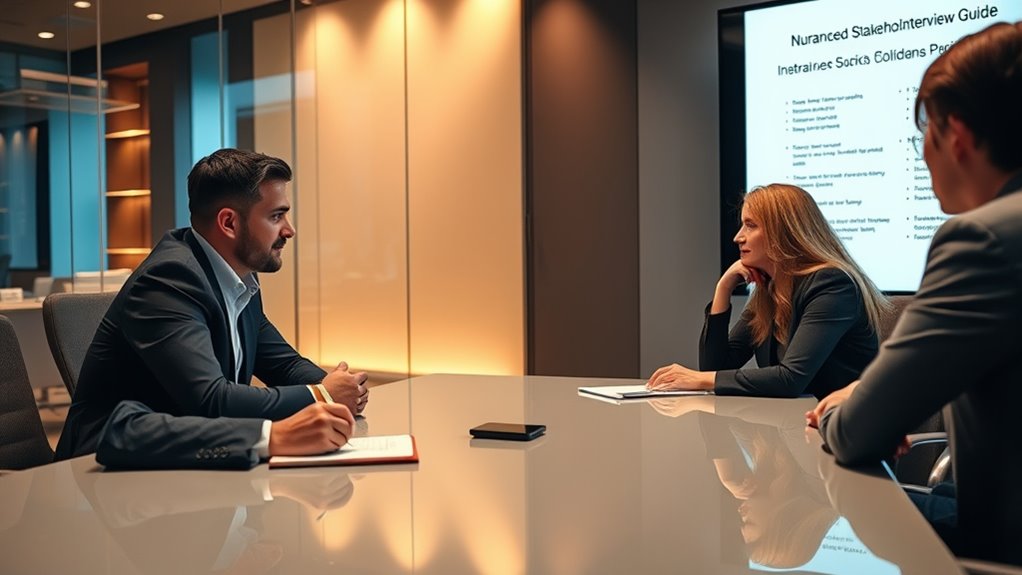To uncover hidden agendas during stakeholder interviews, ask open-ended questions that encourage honesty and transparency, and listen carefully to both verbal and non-verbal cues. Build rapport to create a trusting space and explore potential conflicts, unspoken priorities, or biases by probing into previous experiences and underlying assumptions. Pay attention to subtle responses and cues that reveal true motivations. Keep engaging with effective strategies to gain deeper insights into what truly drives your stakeholders.
Key Takeaways
- Use open-ended, non-leading questions to encourage stakeholders to reveal underlying motives and unspoken concerns.
- Observe non-verbal cues and tone shifts that may indicate hidden agendas or discomfort.
- Ask about past experiences and perceived obstacles to uncover biases and unspoken biases.
- Explore stakeholders’ underlying priorities by inquiring about their core needs and expectations indirectly.
- Create a safe environment to foster honesty, allowing stakeholders to share unspoken assumptions and reservations.
Identifying Underlying Motivations and Interests

How can you effectively uncover what truly drives each stakeholder? Start by recognizing trust issues and communication barriers that might cloud their true motivations. When stakeholders hesitate or give vague answers, it’s often a sign that deeper concerns aren’t being openly shared. Address these barriers by creating a safe environment where they feel heard and respected. Ask open-ended questions that encourage honesty, and listen carefully to their responses. Pay attention to non-verbal cues, as these can reveal hidden interests or frustrations. Building rapport helps break down trust issues, making stakeholders more willing to share what matters most to them. Understanding electric dirt bike horsepower and other technical features can also help you better interpret their priorities and concerns. By fostering transparency and understanding, you’ll gain valuable insights into their underlying motivations and interests.
Exploring Potential Conflicts and Concerns

Building trust and understanding what motivates stakeholders helps create a foundation for open conversations. When exploring potential conflicts and concerns, consider how team dynamics might influence differing viewpoints. Recognize that communication barriers—such as misunderstandings or unspoken assumptions—can hide underlying issues. Asking direct yet empathetic questions encourages stakeholders to share worries they may hesitate to voice. Pay attention to cues that reveal tension or misalignment, as these often signal deeper concerns. Addressing conflicts early prevents escalation and fosters a collaborative environment. Your goal is to identify areas where interests diverge, uncover hidden frustrations, and clarify any miscommunications. Cultivating mindfulness practices can help you remain attentive to subtle cues and underlying emotions during discussions. By doing so, you set the stage for constructive dialogue that aligns stakeholder perspectives and mitigates future misunderstandings.
Uncovering Unspoken Priorities and Assumptions

Unspoken priorities and assumptions often shape stakeholder perspectives more than explicitly stated goals. These hidden beliefs influence how they interpret information and respond during discussions. Communication barriers can obscure these underlying factors, making it harder to identify true motivations. Cultural differences also play a significant role, as varying backgrounds lead to different ways of expressing needs and expectations. To uncover these unspoken elements, ask open-ended questions that encourage reflection and listen carefully for non-verbal cues or subtle hints. Be mindful of language and tone, ensuring you create a safe space where stakeholders feel comfortable sharing what’s often left unsaid. Recognizing and addressing these unspoken priorities helps you build a clearer understanding of stakeholder intentions, leading to more effective collaboration and decision-making. Additionally, understanding the contrast ratio of projectors can reveal underlying preferences for image quality, which stakeholders may not explicitly state but influence their expectations.
Gauging Stakeholder Commitment and Support

Are you confident about the level of commitment and support stakeholders have for your project? To gauge this effectively, ask questions that reveal their willingness to invest time and resources. Understanding their support helps in risk management by identifying potential gaps in engagement early on. You’ll also want to explore how stakeholders plan to allocate resources—financial, human, or technological—to ensure their support is sustained. Clarify their expectations and identify any hesitations that could hinder progress. If stakeholders lack support, project risks increase, and resource allocation may become inefficient. Additionally, understanding the essential oils for support can help identify ways to foster stakeholder well-being and resilience, which indirectly supports project success. By evaluating these factors, you can better anticipate challenges, strengthen stakeholder buy-in, and align their commitment with project goals, ultimately increasing your chances for success.
Detecting Hidden Biases and Influences

Even when stakeholders seem committed and supportive, unspoken dynamics and underlying biases can influence their perspectives in subtle ways. You need to be alert to unspoken agendas that may hide behind their words or body language. Power struggles often drive these hidden biases, affecting decision-making and openness. By asking targeted questions about past experiences and perceived obstacles, you can reveal underlying influences shaping their views. Notice any hesitation or inconsistent responses, which can signal unspoken concerns or rivalries. Recognizing these hidden biases helps you understand the true motivations behind stakeholder positions. Addressing unspoken dynamics directly encourages transparency and reveals true priorities. Being aware of support hours and scheduling nuances can also shed light on underlying priorities and constraints. This proactive approach ensures you’re not misled by surface-level support, allowing for more honest, comprehensive insights.
Frequently Asked Questions
How Can I Build Trust to Encourage Honest Stakeholder Responses?
Building trust is key to encouraging honest stakeholder responses. You can do this by establishing rapport through genuine interest and consistent follow-through. Practice active listening, giving your full attention and asking open-ended questions to show you value their input. Be transparent about your intentions, maintain confidentiality, and stay patient. These steps foster a safe environment where stakeholders feel comfortable sharing honest insights, uncovering hidden agendas effectively.
What Are Effective Ways to Handle Evasive or Guarded Stakeholder Answers?
Think of their guarded answers as locked doors waiting to be opened. Use open-ended prompts to gently turn the key, inviting them to share more beneath the surface. Practice active listening, like holding a mirror up, reflecting their words with empathy and patience. This approach helps create trust, encouraging honesty. Over time, your consistent openness can unbolt deeper insights, revealing what truly matters behind their guarded responses.
How Do Cultural Differences Influence Stakeholder Interview Dynamics?
You should recognize that cultural differences markedly influence stakeholder interview dynamics. Cultural communication styles vary, affecting how openly people share information. By practicing intercultural sensitivity, you adapt your approach to respect diverse communication norms. This awareness helps you interpret responses more accurately and build trust. Being mindful of cultural nuances encourages honest dialogue, reducing misunderstandings and fostering a more productive interview environment across different cultural contexts.
When Should I Adjust Questions to Delve Deeper Into Hidden Agendas?
Back in the day, you’d know when to switch gears. When should you adjust questions to probe deeper? It’s all about question timing—listen for hesitation or vague answers. When your initial probing techniques don’t reveal the full picture, it’s time to dig deeper. Trust your instincts, and don’t hesitate to rephrase or ask follow-up questions to surface hidden agendas, ensuring you get honest, insightful responses.
How Can I Interpret Non-Verbal Cues During Stakeholder Interviews?
During stakeholder interviews, you interpret non-verbal cues by paying close attention to body language and facial expressions. If someone avoids eye contact, crosses their arms, or exhibits tense gestures, they might be hiding concerns or disagreement. Smiles or nods can indicate agreement or comfort. Stay observant and align your questions to clarify these cues, helping you uncover underlying attitudes or hidden agendas effectively.
Conclusion
By revealing hidden agendas, you’re shining a light into the depths of stakeholder minds, like a lantern piercing through fog. Each question acts as a key, opening doors to unspoken truths and unseen biases. When you uncover these silent currents, you’re not just charting a maze—you’re steering a vessel through hidden waters toward clarity and consensus. Trust your questions to reveal the unseen, guiding your journey through the shadows toward a shared horizon.









